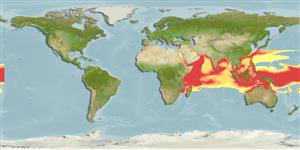Common names from other countries
Issue
This species is considered as a junior synonym of Mobula kuhlii according to White et al., 2017 (Ref. 115945:9). The species page will be removed,.
Environment: milieu / climate zone / depth range / distribution range
Ecologia
marinhas; intervalo de profundidade 0 - 50 m (Ref. 106604). Tropical; 30°N - 21°S
Indo-West Pacific: Red Sea, Arabian Sea and the Persian Gulf to South Africa and the Philippines, north to Viet Nam, south to northern Australia (Ref. 9911). This species is noted as a possible synonym of the earlier Mobula diabolus (Shaw, 1804) in Compagno's 1999 checklist (Ref. 35766).
Tamanho / Peso / Idade
Maturity: Lm ? range ? - ? cm
Max length : 100.0 cm WD macho/indeterminado; (Ref. 6871)
Descrição suscinta
Chaves de identificação | Morfologia | Morfometria
Brownish-grey above, whitish below (Ref. 11228). Underside of pectorals with semicircular black blotch along middle of anterior edge (Ref. 11228).
Found in coastal and oceanic waters (Ref. 30573); solitary of aggregations, sometimes with 50 or more individuals (Ref. 90102). Not known to penetrate the epipelagic zone (Ref. 9911). Feeds on plankton (Ref. 30573). Ovoviviparous (Ref. 50449).
Ciclo de vida ou comportamento de acasalamento
Maturities | Reprodução | Spawnings | Egg(s) | Fecundities | Larvas
Exhibit ovoviparity (aplacental viviparity), with embryos feeding initially on yolk, then receiving additional nourishment from the mother by indirect absorption of uterine fluid enriched with mucus, fat or protein through specialised structures (Ref. 50449).
Compagno, L.J.V., 1999. Checklist of living elasmobranchs. p. 471-498. In W.C. Hamlett (ed.) Sharks, skates, and rays: the biology of elasmobranch fishes. Johns Hopkins University Press, Maryland. (Ref. 35766)
Status na Lista Vermelha da UICN (Ref. 130435)
Ameaça para os humanos
Harmless
Uso pelos humanos
Ferramentas
Relatórios especiais
Baixar XML
Fontes da internet
Estimates based on models
Preferred temperature (Ref.
115969): 25.6 - 29.1, mean 28.2 (based on 2136 cells).
Índice de diversidade filogenética (Ref.
82804): PD
50 = 0.5005 [Uniqueness, from 0.5 = low to 2.0 = high].
Bayesian length-weight: a=0.01000 (0.00244 - 0.04107), b=3.04 (2.81 - 3.27), in cm Total Length, based on all LWR estimates for this body shape (Ref.
93245).
Nível Trófico (Ref.
69278): 3.4 ±0.45 se; based on food items.
Resiliência (Ref.
120179): Baixo, tempo mínimo de duplicação da população 4,5 - 14 anos (Fec assumed to be <100).
Fishing Vulnerability (Ref.
59153): Very high vulnerability (85 of 100).
